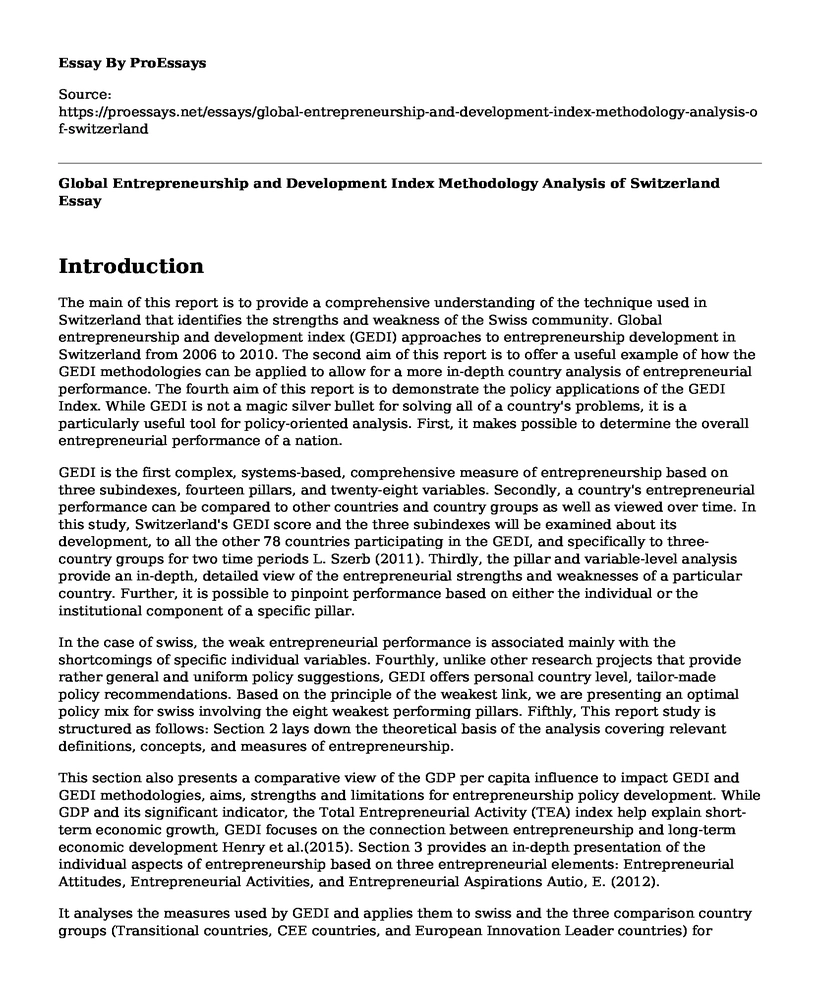Introduction
The main of this report is to provide a comprehensive understanding of the technique used in Switzerland that identifies the strengths and weakness of the Swiss community. Global entrepreneurship and development index (GEDI) approaches to entrepreneurship development in Switzerland from 2006 to 2010. The second aim of this report is to offer a useful example of how the GEDI methodologies can be applied to allow for a more in-depth country analysis of entrepreneurial performance. The fourth aim of this report is to demonstrate the policy applications of the GEDI Index. While GEDI is not a magic silver bullet for solving all of a country's problems, it is a particularly useful tool for policy-oriented analysis. First, it makes possible to determine the overall entrepreneurial performance of a nation.
GEDI is the first complex, systems-based, comprehensive measure of entrepreneurship based on three subindexes, fourteen pillars, and twenty-eight variables. Secondly, a country's entrepreneurial performance can be compared to other countries and country groups as well as viewed over time. In this study, Switzerland's GEDI score and the three subindexes will be examined about its development, to all the other 78 countries participating in the GEDI, and specifically to three-country groups for two time periods L. Szerb (2011). Thirdly, the pillar and variable-level analysis provide an in-depth, detailed view of the entrepreneurial strengths and weaknesses of a particular country. Further, it is possible to pinpoint performance based on either the individual or the institutional component of a specific pillar.
In the case of swiss, the weak entrepreneurial performance is associated mainly with the shortcomings of specific individual variables. Fourthly, unlike other research projects that provide rather general and uniform policy suggestions, GEDI offers personal country level, tailor-made policy recommendations. Based on the principle of the weakest link, we are presenting an optimal policy mix for swiss involving the eight weakest performing pillars. Fifthly, This report study is structured as follows: Section 2 lays down the theoretical basis of the analysis covering relevant definitions, concepts, and measures of entrepreneurship.
This section also presents a comparative view of the GDP per capita influence to impact GEDI and GEDI methodologies, aims, strengths and limitations for entrepreneurship policy development. While GDP and its significant indicator, the Total Entrepreneurial Activity (TEA) index help explain short-term economic growth, GEDI focuses on the connection between entrepreneurship and long-term economic development Henry et al.(2015). Section 3 provides an in-depth presentation of the individual aspects of entrepreneurship based on three entrepreneurial elements: Entrepreneurial Attitudes, Entrepreneurial Activities, and Entrepreneurial Aspirations Autio, E. (2012).
It analyses the measures used by GEDI and applies them to swiss and the three comparison country groups (Transitional countries, CEE countries, and European Innovation Leader countries) for 2006{2010. Altogether 21 variables are described: seven for Entrepreneurial Attitudes, nine for Entrepreneurial Activity, and ve for Entrepreneurial Aspirations. Section 4 follows the same structure as Section 3 and focuses on institutional measures for entrepreneurship. In this case, we analyze 32 institutional variables, 11 for Entrepreneurial Attitudes, 11 for Entrepreneurial Activity, and 10 for Entrepreneurial Aspirations. In both Section 3 and 4, we distinguish between the results according to the 2006{2008 (pre-crisis) and the 2009{2010 (crisis and post-crisis) periods.
Finally, Section 5 focuses on providing specific policy recommendation for Switzerland. The policy suggestions are based on an analysis of the individual and the institutional variables presented in Sections 3and 4, and applying the Penalty for Bottleneck (PFB) and Overall Bottleneck Measure (OBM) methodologies Amoros et al.(2013). We classify Switzerland's 14 GEDI pillars into four categories regarding top policy priority, which denote swiss's main bottlenecks, high policy priority, medium policy priority and low policy priority. We also provide an optimal policy mix for swiss that includes the improvement of the eight worst performing pillars to reach a 0.1 increase in the GEDI index value.
References
Acs, Z. J. and A. Varga (2005), `Entrepreneurship, agglomeration and technological change'. Small Business Economics 24(3), 323{334.)
Acs, Z. J. and L. Szerb (2011), The Global Entrepreneurship and Development Index 2011. Cheltenham, UK: Edward Elgar.
Amoros, J.,Bosma N. &Levie, J.,2013. Ten years of global entrepreneurship monitor: Accomplishments and prospects.International Journal of Entrepreneurial Venturing. 5(2) pp.120-152.
Autio, E. (2012), `Introduction'. In: Z. J. Acs and L. Szerb (eds.): The Global Entrepreneurship and Development Index 2012. Cheltenham UK: Edward
Cite this page
Global Entrepreneurship and Development Index Methodology Analysis of Switzerland. (2022, May 16). Retrieved from https://proessays.net/essays/global-entrepreneurship-and-development-index-methodology-analysis-of-switzerland
If you are the original author of this essay and no longer wish to have it published on the ProEssays website, please click below to request its removal:
- The Legal Framework of International Investment Protection
- Case Study on the Matter of Deontological and Teleological Frameworks to International Business
- Essay on Hardee's: Employee Development Challenges and Performance Struggles
- Essay Example on Foodservice Management: Job Opportunities in Higher Ed
- Grand Opening Event of Dottie Restaurant - Essay Sample
- Essay Example on Business Law & Ethics: Case Studies & Applications
- Become an Entrepreneur: Pursuing Business Management - Admission Essay Sample







